How do you assess the best return on your investment when purchasing a lighting system for your business? When building an ROI, comparing LED versus HPS luminaires, be careful with results supplied by manufacturers of only one type of light source. You would be well advised to do your homework and perform your own calculations, and to work with a manufacturer like P.L. Light Systems. We produce both HID and LED lighting products, and will thus not be biased toward any one technology. In this article, we will examine what to consider when determining your ROI for an LED, HPS, or hybrid application.
Before deciding what lighting solution is best suited to your application, there are a few things to consider:
EFFICIENCIES
Photosynthetic efficiency measures how efficiently a horticultural lighting system converts electrical energy into PAR photons with micromoles per joule (μmol/J).
In the interest of providing an unbiased comparison, the example below is based on P.L. Light Systems’ NXT2 (HPS) and HortiLED TOP 2.0 (LED) luminaires:
The HortiLED TOP 2.0 is a 336W light with a PPF of 1100 μmol―delivering an efficacy of 3.3 μmol/J (1100 / 320 = 3.2738). The 1000W DE HPS NXT2 has an output of 2100 μmol―delivering an efficacy of 2.1 μmol/J (2100 / 1000 = 2.1).
Many LED manufacturers will show how quickly they can hit a good ROI with LEDs and use 1.85 μmol/J as their HPS comparison. However, most comparisons of new LED technology are made against older magnetic ballast HPS luminaires. These lamps have an output of 1850 μmols at 1000W. Some manufacturers use as low as 1.7 μmol/J for an HPS comparison, which is equivalent to the end-of-life output of the old HPS lamp technology. Therefore, when comparing efficiency in terms of μmol/J, it is important to look at the most recent technology and make calculations that way.
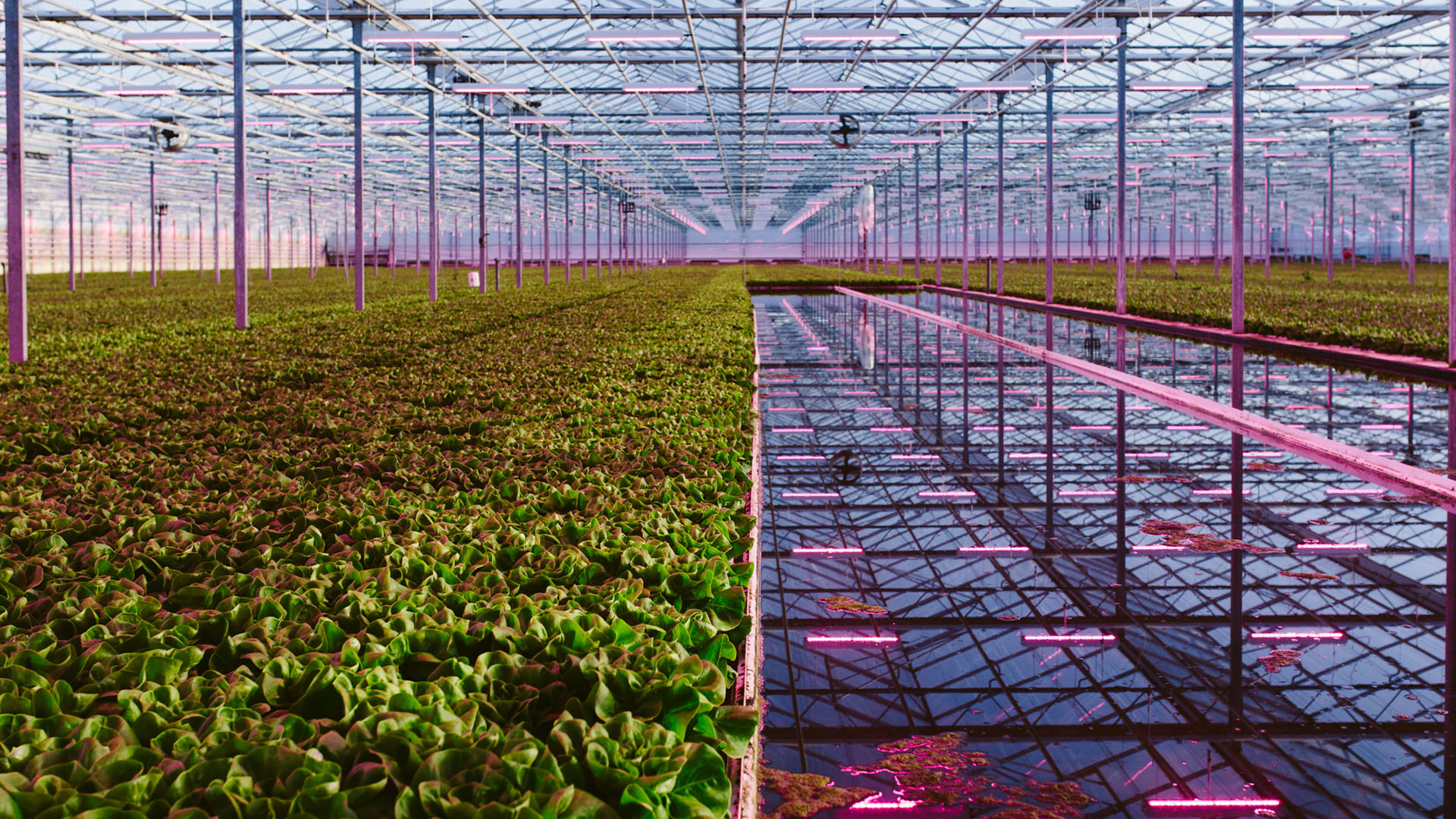
LIGHT PLANNING
When comparing different lighting technologies, always compare light levels of the entire growing area and not just the luminaire-to-luminaire output. There is no such thing as a 1-for-1 replacement of HPS by LED. Some LEDs have an output that looks equal to or even greater than an HPS light alternative when measured directly beneath the luminaire. However, when you move the PAR sensor in any direction away from centered directly beneath the LED, the light level decreases much more rapidly in any given direction under the LED than the HPS luminaire because of the highly focused light distribution and lack of reflector technology in the LED technology.
By the nature of their design, LEDs are a very directional source of light. If a crop is grown under lighting that is not distributed uniformly across the canopy but instead has areas of high intensity and low intensity, it will cause issues as the higher intensity areas will use more water, absorb nutrients, and grow at a different rate than the lower intensity areas. To truly have an equal comparison, be sure to compare light plans with the same targeted light level in micromoles and close to the same average uniformity number.
HEATING/COOLING
Another area you should always do your own math on is the BTU calculation for your grow area. Since LED lighting emits less heat than HPS luminaires, this can be a deciding factor since the cost to cool a grow area can be one of your highest production costs. Your AC load is based on the number of BTUs produced from your grow lights, as 1 watt equals 3.412 BTUs. No matter which 1000W HPS lamp you use, the BTUs will be 3412 BTUs.
P.L. Light Systems HortiLED TOP is a 336 watt LED luminaire, so the BTUs will be 1146 BTUs. While that looks like a big savings, it will take at least twice the number of LEDs to achieve the same light level with a 1000W HPS. The other side of this argument is that the LED luminaires do not emit the same radiant heat as HPS lamps and your crop will perform better with the added warmth. There is a correlation between temperature and crop production – plants will grow slower, producing less yield the colder they are. In northern climates, many growers rely on the heat from HPS horticulture lights to warm their crops.
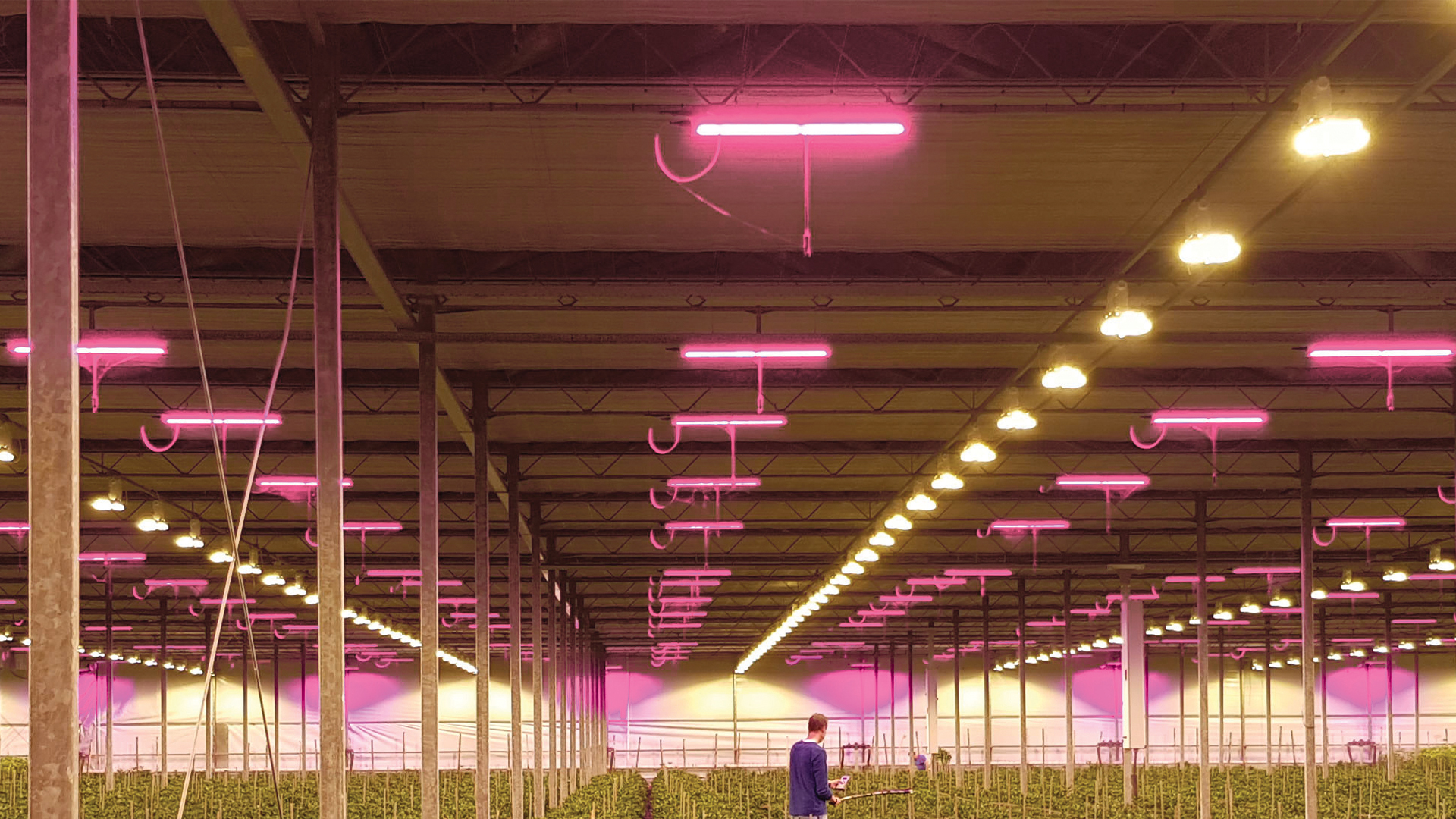
CANOPY PENETRATION
How the light penetrates the crop canopy is a big consideration when comparing HID and LED technologies. There is no easy math to calculate an ROI for this. However, when comparing light plans from one source of light to another, consider the distance of the light source from the canopy.
There is a big misconception in the industry that the ability to have your LED lights closer to your crop will help increase production lower into the crop. Still, when your light source is closer to the top of the canopy, the shadows created by the top layer of leaves are much bigger than if the light was further away. Also, light penetration into the crop comes from the crossover between fixtures. This is easily accomplished by HPS luminaires, which use reflectors to diffuse light―uniformly delivering a much wider range of illumination deep into the canopy at further distances away. Conversely, LEDs will need to be spaced more closely together to achieve higher uniformity over the crop canopy.
EXAMPLES:
We have created an example of two comparative light plans, based on all HPS vs. all LED for the same application.
HPS Example:
1000W Electronic NXT2 HPS Double Ended luminaires for a Grow Area that is 40ft x 120ft
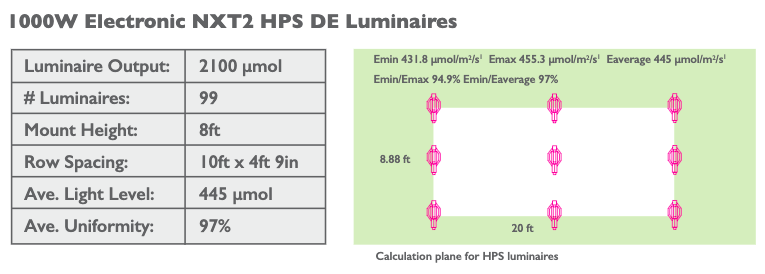
LED Example:
336W HortiLED TOP 2.0 LED luminaires for a Grow Area that is 40ft x 120ft

As you can see, for the HPS solution, we can achieve 445 µmols with 99 x 1000W luminaires hung on 10ft spaced trusses. To achieve the same light level with LEDs, we need to use more lights than the HPS layout, and cannot achieve uniformity, nor fit them all if we try to hang them on the 10 ft truss. In this case, we would have to install an additional track to fit the number of LEDs required.
In addition, the reflector technology in the HPS luminaires helps diffuse the light by reflecting and refracting photons around the grow area in different directions. This is in contrast to an LED that directs photons directionally downward. So, while the plans have targeted the same light level at the crop canopy, you also need to take into consideration the number of photons being delivered to the crop.
For the LED application―160 luminaires at 1100 µmol/m2/s output each―produce a total of 176,000 µmols of photons per second for this entire space. The 99 HPS luminaires with an output of 2100 µmol/m2/s each produce 207,900 µmols of photons per second. The question is, which one will your crop perform better under? The simple answer looks like it would be HPS lights. However, if your plant uses the blue and red wavelengths of light more efficiently than other areas of the PAR spectrum, then LEDs might work better for your crop. This is because some of those photons from the HPS luminaires are not utilized by plants for photosynthesis.
You can calculate the payback period for LED grow lights by weighing the initial incremental capex costs versus the resulting energy savings.
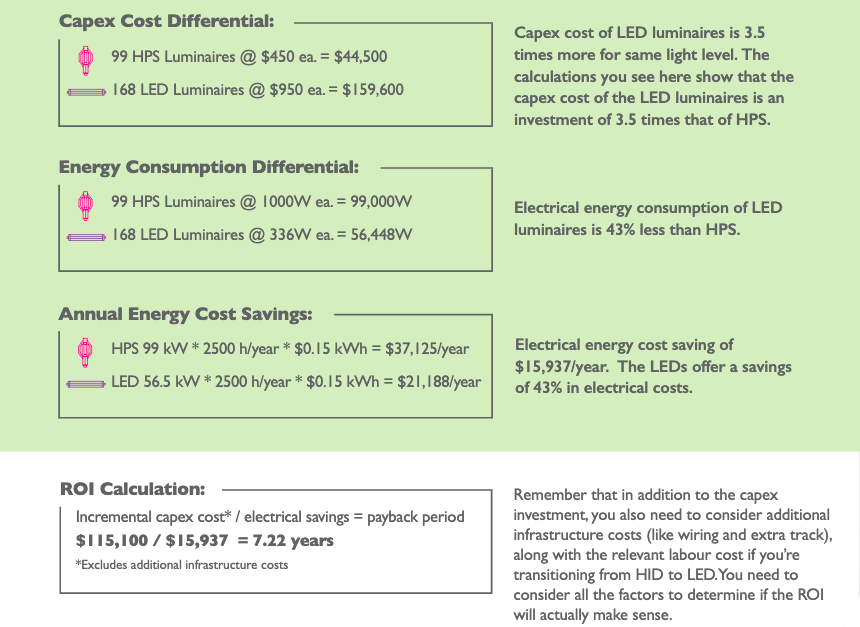
Hybrid ROI Example
Let’s look at how a hybrid LED and HPS lighting system might differ from an all-LED or all-HPS system. In this plan, we replaced every other HPS luminaire with two LEDs. The light spacing also means they can still be mounted on the 10ft truss, rather than having to install an additional track, as was the case with the all-LED solution.

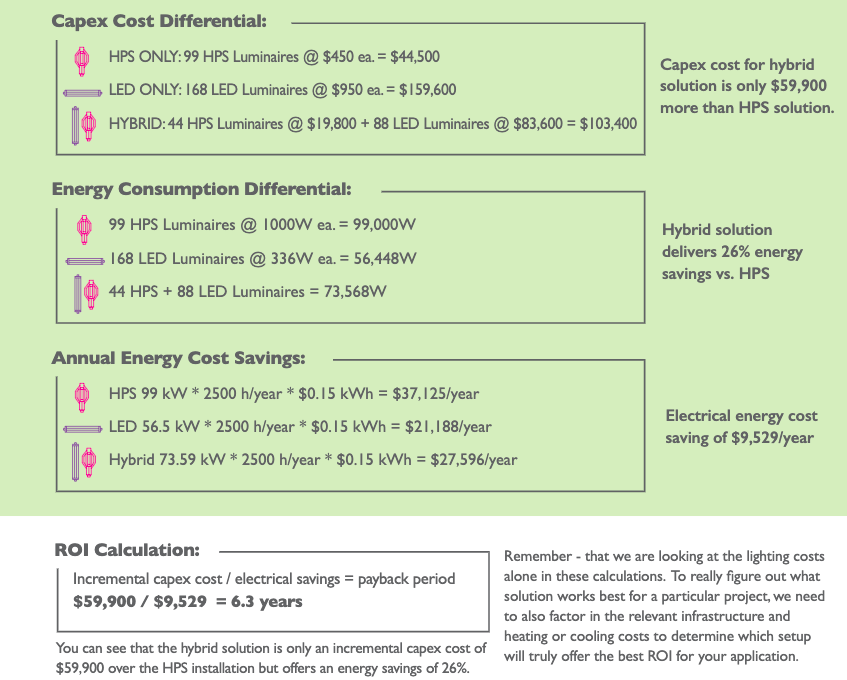
You can see that the hybrid solution has an incremental capex cost of $59,900 over the HPS installation but offers an energy savings of 26%.
Remember, we are looking at the lighting costs alone in these calculations. To really determine what solution works best for a particular project, we need to also factor in the relevant infrastructure and heating or cooling costs to determine which setup will truly offer the best ROI for your application.
Click here to get started on your own custom light plan to see how P.L. Light Systems can help grow your business.


